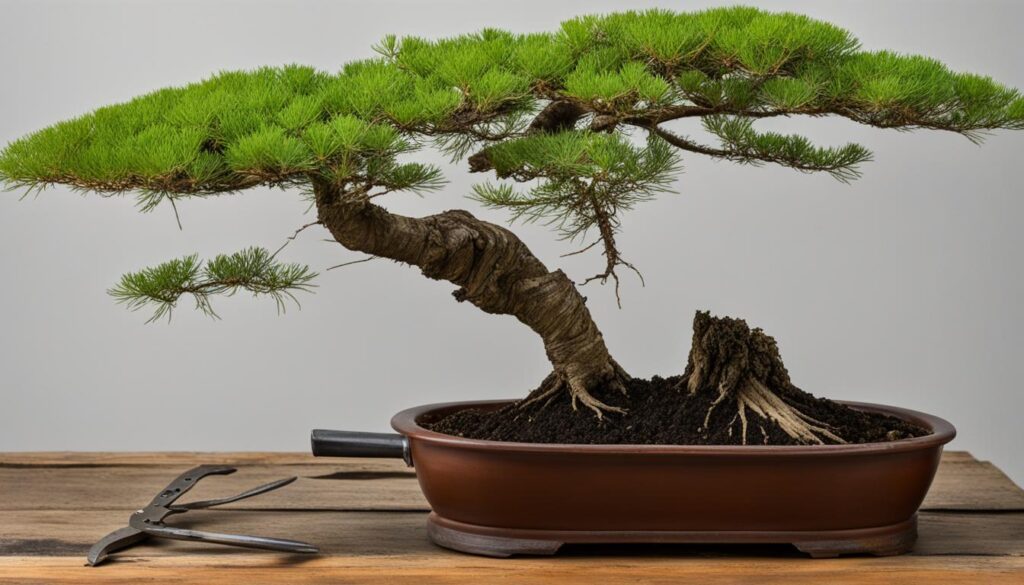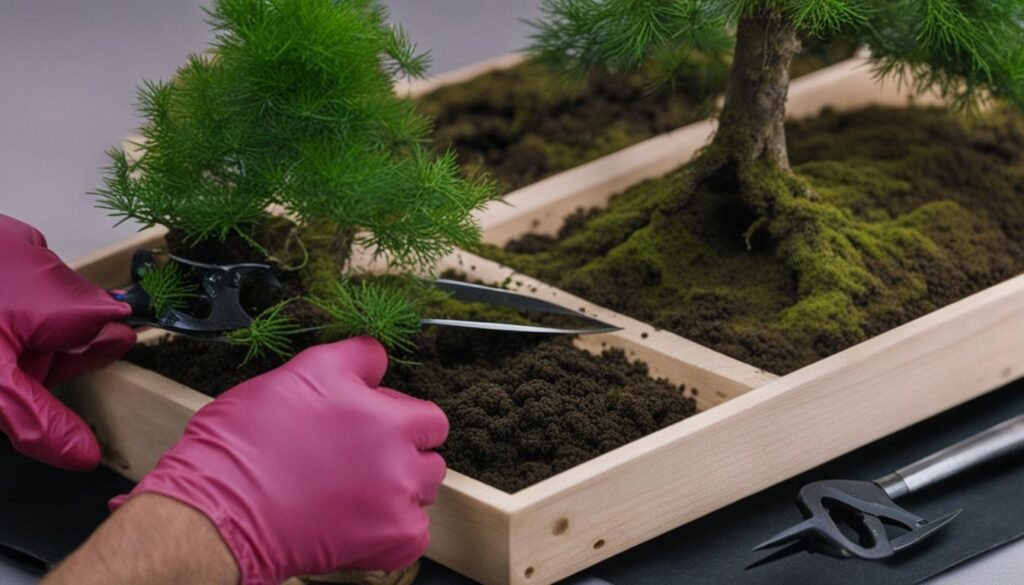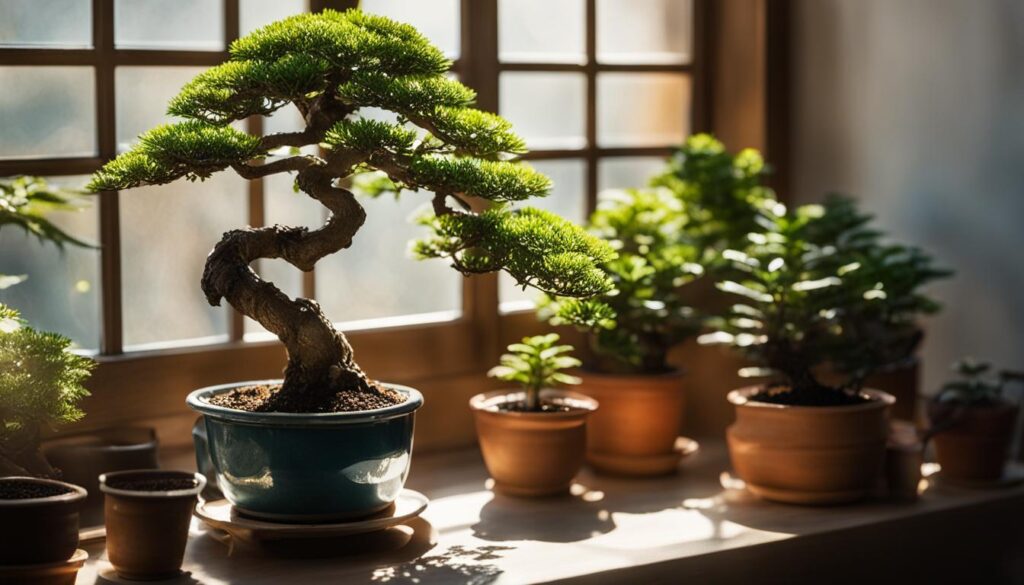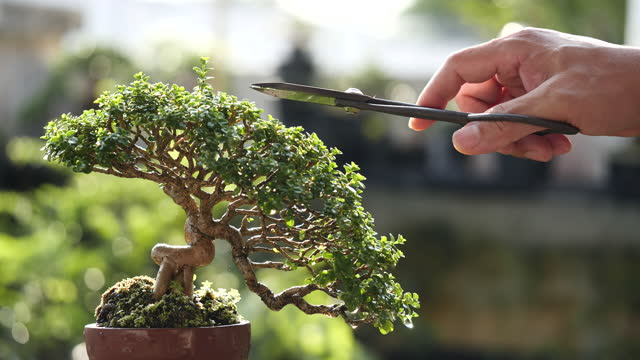Welcome to our comprehensive guide on caring for your swamp cypress bonsai. Throughout this guide, we will explore the unique characteristics of the swamp cypress bonsai and provide you with valuable tips on bonsai tree care. From understanding its history and origin to mastering pruning, watering, fertilizing, and re-potting techniques, you’ll discover everything you need to know to nurture your bonsai.
So, whether you have a passion for bonsai or simply want to add a touch of nature and tranquility to your home, this guide is the perfect companion to help you cultivate and nurture your very own swamp cypress bonsai trees.
Understanding Your Swamp Cypress Bonsai
In this section, we will delve into the rich history and origin of the swamp cypress bonsai tree, also known as Taxodium distichum. We will explore its unique identifying characteristics, such as its bark, leaves, and cypress knees. Additionally, we will compare the swamp cypress with other popular bonsai tree species to understand its distinct qualities.
The Rich History and Origin of Taxodium distichum
The swamp cypress bonsai tree, scientifically known as Taxodium distichum, has a fascinating history and origin. It is native to the southeastern United States and is often found in wetland areas such as swamps and marshes. The tree has been cultivated for centuries, with its bonsai form dating back to ancient Japan. The swamp cypress bonsai is highly regarded for its beauty and distinctive features.
Identifying Characteristics: Bark, Leaves, and Cypress Knees
One of the unique characteristics of the swamp cypress bonsai is its bark. The bark starts out reddish-brown and turns grayish-brown as the tree matures. It has a fibrous texture that adds visual interest to the bonsai’s overall appearance.
The leaves of the swamp cypress bonsai are needle-like and typically emerge in a bright green color. As the seasons change, the leaves transition to an attractive bronze or reddish-brown hue before falling in the winter. This seasonal color change creates a stunning display.
Another notable feature of the swamp cypress bonsai is the presence of cypress knees. These are unique structures that protrude from the roots and can add a sense of character and depth to the bonsai’s design. Cypress knees are believed to aid in the tree’s stability and water intake.
Comparing Swamp Cypress with Other Bonsai Species
The swamp cypress bonsai is a distinct species within the realm of bonsai trees. While it shares some characteristics with other bonsai species, such as the need for proper care and attention, it possesses its own unique qualities. When compared to other bonsai tree species, the swamp cypress stands out for its:
- Adaptability to wetland environments
- Seasonal color changes
- Fibrous and interesting bark
- Possession of cypress knees
These qualities make the swamp cypress bonsai a desirable choice for bonsai enthusiasts looking to cultivate a tree with distinctive features.
Where to Place Your Bonsai for Optimal Growth

Proper placement is essential for the optimal growth of your swamp cypress bonsai tree. To ensure your bonsai thrives, it’s important to consider its sunlight requirements, protection from extreme weather conditions, and the appropriate level of humidity.
When choosing a location for your bonsai, keep the following tips in mind:
- Place your bonsai tree in an area that receives ample sunlight. Most bonsai trees, including the swamp cypress, thrive in bright, indirect light. Avoid placing your bonsai in areas with prolonged exposure to direct sunlight, as it can lead to leaf burn.
- Protect your bonsai from extreme weather conditions, such as strong winds and frost. Consider placing it near a wall, under a shade tree, or in a sheltered area to shield it from harsh elements.
- Maintain the right level of humidity for your bonsai. The ideal humidity range for most bonsai trees, including swamp cypress, is between 40% and 60%. You can increase humidity by placing a humidity tray filled with water near your bonsai or by using a humidifier in dry environments.
By carefully selecting the placement of your bonsai, you can provide it with the optimal conditions for growth and ensure its long-term health and vitality.
Watering Cypress Bonsai Trees
Proper watering is crucial for the health and vitality of your swamp cypress bonsai tree. In this section, we will provide you with essential guidelines on how to effectively water your bonsai and maintain the right moisture level for optimal growth.
Watering frequency depends on various factors such as climate, humidity, and the size of your bonsai pot. As a general rule, it is recommended to water your swamp cypress bonsai regularly, allowing the soil to slightly dry out between waterings. This will ensure that the roots receive adequate hydration without becoming overly saturated.
When watering your bonsai, it is essential to use the right technique. Instead of pouring water directly onto the foliage, gently water the base of the tree, allowing the water to seep into the soil and reach the roots. This will promote deep root growth and prevent unnecessary foliage damage.
Avoid overwatering your swamp cypress bonsai as it can lead to root rot and other detrimental conditions. It is better to slightly underwater than to overwater. Remember, roots need both water and oxygen to thrive.
To determine when to water your bonsai, it is helpful to check the moisture level of the soil. You can do this by inserting a wooden chopstick or your finger into the soil. If it comes out slightly damp, it is an indication that your bonsai does not require immediate watering. However, if it comes out dry, it is time to water your tree.
As a beginner, it is recommended to keep a watering schedule and monitor the moisture level regularly. This will help you establish a watering routine that suits your specific bonsai tree.
Remember, each bonsai tree is unique, and its water requirements may vary. Pay attention to the specific needs of your swamp cypress bonsai and adjust your watering routine accordingly.
Nourishing Your Bonsai: Fertilizing Techniques

Fertilizing is crucial for providing essential nutrients to your swamp cypress bonsai tree. By nourishing your bonsai tree with the right fertilizing techniques, you can promote its overall health and growth.
When it comes to fertilizing your bonsai tree, it’s important to choose the right type of fertilizer that suits the specific needs of your swamp cypress. Look for a well-balanced, slow-release fertilizer that contains the necessary nutrients, such as nitrogen, phosphorus, and potassium.
To ensure optimal growth, fertilize your bonsai tree during the growing season, which typically starts in early spring and ends in late summer or early fall. This is when your bonsai tree requires the most nutrients to support its vigorous growth and development.
When applying fertilizer to your bonsai tree, follow the instructions provided on the fertilizer packaging. It’s essential to apply the correct amount of fertilizer to prevent overfertilization, which can harm your tree. Remember to water your bonsai tree thoroughly before and after fertilizing to help the nutrients penetrate the soil.
Tip: Consider using organic fertilizers to nourish your bonsai tree. These fertilizers are derived from natural sources and help enhance the overall soil quality, promoting the well-being of your swamp cypress bonsai.
In conclusion, fertilizing your bonsai tree is an essential aspect of its care. By choosing the right type of fertilizer, timing your fertilization correctly, and applying the fertilizer properly, you can provide your swamp cypress bonsai with the necessary nutrients for healthy growth and vibrant foliage.
| Fertilizing Techniques for Swamp Cypress Bonsai |
|---|
| Choose a well-balanced, slow-release fertilizer |
| Fertilize during the growing season (early spring to late summer/early fall) |
| Follow fertilizer instructions; avoid overfertilization |
| Water bonsai tree before and after fertilizing |
| Consider using organic fertilizers for improved soil quality |
Maintaining Shape and Health: Pruning and Wiring
Pruning and wiring are essential techniques for maintaining the shape and health of your swamp cypress bonsai tree. By carefully pruning and wiring your bonsai, you can create beautiful and harmonious designs that enhance the aesthetic appeal of your tree.
When it comes to bonsai tree pruning, timing is key. Prune your tree during its dormant period, typically in late winter or early spring. Begin by removing any dead or damaged branches to promote healthy growth. Use sharp, clean pruners to make precise cuts, ensuring smooth edges that heal quickly.
Next, analyze your tree’s structure and envision the desired shape. Carefully prune back branches to maintain the tree’s overall form and proportions. Remember to consider the future growth of each branch, ensuring an open and well-balanced canopy. Regular pruning will prevent overcrowding and allow sunlight to reach the inner branches for optimal growth.
After pruning, it’s important to take into account the health of your tree. Applying a wound sealant, such as cut paste or pruning seal, can protect the tree from infections and promote healing. However, for swamp cypress bonsai trees, which have excellent healing capabilities, sealants may not be necessary.
Wiring is another technique used to shape and style your bonsai tree. Select flexible bonsai wire that matches the thickness of the branch you intend to wire. Gently wrap the wire around the branch, starting from the base and moving upward. Make sure the wire is snug but not too tight, allowing room for growth.
Avoid crossing wires and position them at an angle that creates natural movement. Wiring allows you to create curves, bends, and twists, guiding the branches in the desired direction. However, be mindful not to leave the wire on for too long, as it may leave marks or cut into the bark.
Mastering the Re-potting of the Bald Cypress Bonsai
Re-potting is an essential process to ensure the continued health and growth of your bald cypress bonsai tree. By providing your bonsai with fresh soil and adequate space for root development, you can create optimal conditions for its long-term well-being.
When re-potting your bald cypress bonsai, there are several important steps to follow:
- Selecting the right time: Re-potting is typically done every 2-3 years, ideally during early spring before new growth begins. This allows the roots to establish in the new pot before entering their active growth phase.
- Preparing the tree: Carefully remove the bonsai tree from its current pot, gently teasing out the roots to untangle any densely packed areas. Trim any damaged or excessively long roots, ensuring a balanced root system.
- Choosing the right soil: Bald cypress bonsai trees thrive in well-draining soil. Use a mix of Akadama, pumice, and lava rock, which promotes healthy root growth and prevents waterlogging. The soil should be slightly acidic.
- Repotting the tree: Place a layer of soil in the new pot, ensuring it covers the drainage holes. Position the bonsai tree in the center of the pot, spreading out the roots evenly. Fill the remaining space with soil, gently working it around the roots to eliminate air pockets. Leave a small gap at the top to allow for watering.
- Watering and aftercare: After re-potting, thoroughly water the bonsai to settle the soil and remove any excess air. Place the bonsai in a shaded location for about two weeks to minimize stress. Gradually reintroduce it to sunlight, monitoring its water needs closely during this recovery period.
Mastering the re-potting process is crucial for the long-term vitality of your bald cypress bonsai. By following these steps and providing your bonsai with the right care, you can ensure its continued growth and beauty.
Propagating Your Swamp Cypress Bonsai

Propagating your swamp cypress bonsai tree is an exciting way to expand your collection or share the beauty of bonsai with others. In this section, we will explore two methods of propagating your bonsai: using seeds and cuttings.
To propagate your swamp cypress bonsai tree from seeds, follow these steps:
- Harvest seeds from mature cones of the parent tree.
- Clean the seeds to remove any debris.
- Soak the seeds in water for 24 hours to enhance germination.
- Prepare a seed tray or small pots with a well-draining soil mixture.
- Plant the seeds about 1/4 inch deep in the soil.
- Place the tray or pots in a shaded area with indirect sunlight.
- Keep the soil consistently moist but not waterlogged.
- Germination usually takes several weeks to a few months.
- Once the seedlings have developed into small trees, carefully transplant them into individual bonsai pots.
Alternatively, you can propagate your swamp cypress bonsai tree through cuttings:
- Select a healthy branch for cutting, preferably from the parent tree.
- Using sharp and clean pruners, cut a 4-6 inch section of the branch just below a leaf node.
- Remove the lower leaves, leaving only a few at the top.
- Dip the cut end in a rooting hormone powder to encourage root development.
- Prepare a rooting medium of well-draining soil or a mix of perlite and peat moss.
- Insert the cutting about an inch deep into the rooting medium.
- Place the pot or tray in a warm and humid environment with indirect sunlight.
- Keep the soil slightly moist, not overly wet.
- Roots should start developing in a few weeks to a couple of months.
- Once the cuttings have established a good root system, transplant them into individual bonsai pots.
By following these propagation techniques, you can successfully create new swamp cypress bonsai trees and continue to enjoy the art of bonsai.
Pest and Disease Prevention
Protecting your swamp cypress bonsai tree from pests and diseases is vital to its overall health and long-term survival. In this section, we will explore the common pests and diseases that can pose a threat to your bonsai tree and provide effective preventive measures to ensure its continued thriving.
Pest Prevention:
Common pests that can infest your bonsai tree include aphids, spider mites, and scale insects. To prevent infestations, regularly inspect your tree for any signs of pests, such as distorted leaves, sticky residue, or tiny insects. If you spot any pests, take immediate action by manually removing them or using an organic insecticidal soap. Additionally, promoting a healthy growing environment by maintaining proper watering, fertilizing, and sunlight conditions will strengthen your bonsai tree’s natural defenses against pests.
Disease Prevention:
Bonsai tree diseases, such as root rot and fungal infections, can be detrimental to your swamp cypress’s health. To prevent diseases, ensure proper drainage by using well-draining soil and avoiding overwatering. Additionally, sanitize your tools before each use to prevent the spread of pathogens. If you notice any signs of disease, such as yellowing leaves, wilting, or unusual spots, take prompt action by pruning away the affected parts and applying a suitable fungicide, following the product’s instructions carefully.
By prioritizing pest and disease prevention, you can safeguard the long-term beauty and vitality of your swamp cypress bonsai tree. Regular monitoring, proper care practices, and swift action when needed will contribute to a healthy and thriving bonsai tree that brings you joy and admiration for years to come.

Karen Phillips, Bonsai expert and blogger. Read more about me here



